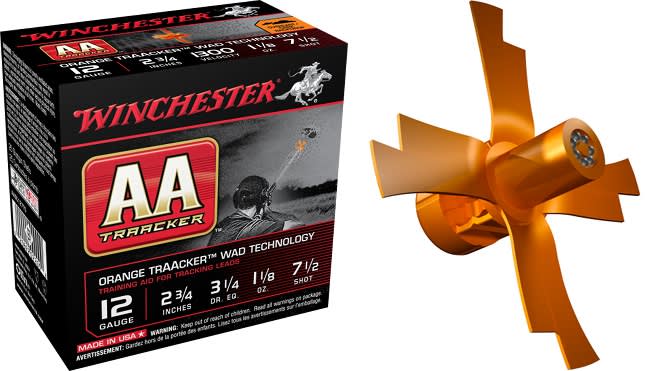Using Winchester AA TrAAcker as a Training Aid
Bill Miller 04.14.15

Wingshooting would be such an easy pursuit if we were shooting laser guns from the old sci-fi movies. You know, the ones alien shooters used to project a continual beam of disintegration at their intended targets. We’d simply watch the beam and easily adjust for lead on any moving target no matter how evasive its maneuvers.
If you’ve ever set foot on a shotgun range or into an upland field or duck blind, you know it doesn’t work that way. Learning to consistently center a shot pattern you can’t see on a moving target is to master physics, muscle memory, and a good bit of art. And it takes time.
By allowing the shooter (and his or her coach) to easily see the path of the shot pattern to the target, the Winchester AA TrAAcker load helps to flatten that learning curve and offers advantages to experienced shooters, too. Their specially-designed wads keep up with the shot string, fly straight, and come in colors to maximize visibility in any sky conditions, including night time under the lights.
 While a coach analyzing a student’s shots will be able to see the tracer effect immediately, working solo it will take the shooter about 50 rounds to train his or her eyes to see the TrAAcker wad in flight. Learning to see the TrAAcker wad arrive on target offers an additional benefit for the shooter.
While a coach analyzing a student’s shots will be able to see the tracer effect immediately, working solo it will take the shooter about 50 rounds to train his or her eyes to see the TrAAcker wad in flight. Learning to see the TrAAcker wad arrive on target offers an additional benefit for the shooter.
One of the most common flaws in wingshooting technique—one that haunts both novice and experienced shooters—is focusing on the shotgun’s bead(s) rather than downrange to pick up the target. In severe cases, the shooter’s focus shifts back and forth several times during a shot. The telltale sign of this breach of form is the muzzle wiggling around as if the shooter was tracing figure eights rather than executing a smooth swing to and through the target.
To see the TrAAcker wad in flight, the shooter’s vision must be focused downrange. The subconscious thought of “looking for the wad” forces focus downrange, thereby enhancing technique and instilling good habits over bad. This phenomenon can especially help an experienced shooter halt a slump caused by looking at the bead(s).
Once a shooter learns to see the TrAAcker wad, it becomes as important to training the mental game as the physical. Once a shooter creates the muscle memory it takes to break targets, and gains enough experience to understand what he or she is seeing in various presentations, shotgunning becomes a 95 percent mental game.
All types of competitive athletes, from race car drivers to downhill skiers to golfers, train in mental visualization—seeing desired outcomes in the mind’s eye before they happen. This is a crucial skill for top shotgunners, too; just ask the phenoms on the USA Shooting Team. They “see” every target break as they prepare for the shot.
 Using the Winchester AA TrAAcker in training creates a real-world picture of the shot string inking the target. It’s an image you can incorporate into your visualization routine for greater success. Once a shooter is secure in the ability to actually see TrAAcker’s in flight, it’s an interesting and beneficial drill to mix them with non-TrAAcker loads. Instruct the shooter to load without identifying which shell they are putting into the gun. Shooters incorporating proper visualization will likely believe they see the TrAAcker on every shot whether it’s there or not. That’s a strong mental game!
Using the Winchester AA TrAAcker in training creates a real-world picture of the shot string inking the target. It’s an image you can incorporate into your visualization routine for greater success. Once a shooter is secure in the ability to actually see TrAAcker’s in flight, it’s an interesting and beneficial drill to mix them with non-TrAAcker loads. Instruct the shooter to load without identifying which shell they are putting into the gun. Shooters incorporating proper visualization will likely believe they see the TrAAcker on every shot whether it’s there or not. That’s a strong mental game!
The AA TrAAcker’s sweet spot for “trackability” is 35 to 45 yards, which makes it a natural training aid for American trap shooters. American trap targets are launched to fly at approximately 47 mph and elevated to fly 50 yards before hitting the ground. This makes the peak of the flight arc occur approximately 25 yards beyond the front of the trap house. In a standard singles event, the front of the house is 16 yards in front of the shooter. If the target is broken at the optimal point, the peak of its arc, the distance from the shooter to the bird is 41 yards—the middle of the TrAAcker’s sweet zone. Yet TrAAcker loads also allow ample margins for shooters who break targets on the way up.
Winchester AA TrAAckers are also valuable training aids on the sporting clays course and on the skeet field. It may take the shooter additional visual training to learn to see the wads at closer ranges and against varied backgrounds. However, with a coach at his or her side there will be no questions about where the pattern is shooting in relation to the target. The visual advantage of TrAAckers speeds improvement in the skills of shooters at all experience levels—coached or uncoached.
These insights brought to you by Federal Premium Ammunition, Camp Chef, and the Quebec Outfitters Federation.


